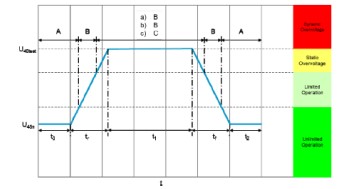LV 148 Standards are written for electric and electronic components for vehicles with a 48V Electrical System. This standard details a series of procedures for a test involving electrical normative bases and addressing the practical challenges for vehicle components and systems.
LV 148 covers electric and electronic components for vehicles within a 48V electrical system's test conditions. Topics and tests covered include tolerances, operating voltage ranges, and other standard values and specifications. With an increasing amount of completely electric vehicles manufactured every year, the LV 148 will remain relevant in the coming decades to ensure standards.
There are two main test setups LV 148 applies for voltage simulations and voltage dropouts.
Test setup for voltage simulation
- DC source
- Signal generator
- Auxiliary equipment
- Measuring devices
Test setup for voltage dropouts
- DC source
- Electronic switch
- Signal generator
- Auxiliary equipment
- Measuring devices
In addition, the LV 148 standards apply to ground offset, short circuit signal and power line, standby current, the ground lost, internal dielectric strength, operations with/without functional limitation, over-voltage range, and under-voltage range tests.
| Tolerances & Standard Values |
| Frequencies |
±1% |
| Temperatures |
±2 °C |
| Humidity |
±5% |
| Times/durations |
+5%; 0% |
| Voltages |
±0.5% |
| Currents |
±2% |
| Room Temperature |
TRT = 23 °C ± 5 °C |
| Humidity |
25 % (+ 5 % bis 0 %) to 75 % (- 5 % bis 0 %) |
| Test Temperature |
Ttest = TRT |
| Operating Voltage |
U48max |
| Source Impedance |
10 mOhm ≤ Ri ≤ 100 mOhm |
| A, B, C, D in Diagrams |
Functional status A, B, C, D |
| BN12 |
12V-on board supply |
| BN24 |
24V-on board supply |
| BN48 |
48V-on board supply |
| GND |
Ground – Masse BN12/BN24 (Kl. 31) |
| GND48 |
Ground 48 V – Masse BN48 (Kl. 41) |
| n.c. |
Not connected |
| PTB |
Physikalisch-Technische Bundesanstalt |
| RMS |
Root Mean Square |
The LV 148 has five different function statuses:
Functional status A
The DUT must fulfill all functions during and after exposure to the test parameters.
Functional status B
The DUT must fulfill all functions during exposure to the test parameters; however, one or more functions can lie outside the specified tolerance. After exposure to the test parameters, the DUT must automatically achieve functional status A again.
Functional status C
The DUT does not fulfill one or more functions during exposure to the test parameters. After exposure to the test parameters, the DUT must automatically achieve functional status A or B again. Undefined functions are not permissible at any time.
Functional status D
The DUT does not fulfill one or more functions during exposure to the test parameters. After exposure to the test parameters, the DUT must achieve functional status A again by means of a terminal changeover, a reset, or a simple intervention (e.g., replacement of a defective fuse). Undefined functions are not permissible at any time.
Functional status E
The DUT does not fulfill one or more functions during exposure to the test parameters and must be repaired or replaced after exposure to the test parameters. The device under test (DUT) must comply with the requirements for nonflammabilit.

S
Requirements: Components which convert electrical energy. Functional status B Components necessary for driving operation: Functional status B For all other components: Functional status C.